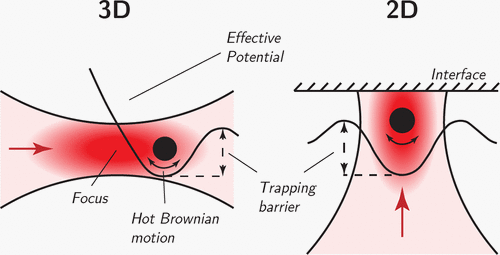当前位置:
X-MOL 学术
›
ACS Photonics
›
论文详情
Our official English website, www.x-mol.net, welcomes your
feedback! (Note: you will need to create a separate account there.)
Optical Tweezing and Photothermal Properties of Resonant Dielectric and Metallic Nanospheres
ACS Photonics ( IF 6.5 ) Pub Date : 2020-07-20 , DOI: 10.1021/acsphotonics.0c00292 Nils Odebo Länk 1 , Peter Johansson 1, 2 , Mikael Käll 1
ACS Photonics ( IF 6.5 ) Pub Date : 2020-07-20 , DOI: 10.1021/acsphotonics.0c00292 Nils Odebo Länk 1 , Peter Johansson 1, 2 , Mikael Käll 1
Affiliation

|
Optically trapped nanoparticles can be used as efficient mobile probes of nanoscopic forces and temperatures. However, it is crucial that the trapped particle has minimal influence on the system under study while providing a strong enough optical response to actually allow for optical manipulation. This puts severe constraints on the particle size and thermal properties. In particular, strong optical responses associated with plasmon resonances in noble metal nanoparticles and Mie resonances in high index dielectric particles can significantly affect trap stability through enhanced radiation pressure forces and photoinduced heating. Using Mie theory and hot Brownian motion analysis, we calculate trap stability and photothermal properties for nanospheres composed of the best (Ag) and most widely used (Au) plasmonic materials as well as for crystalline and amorphous Si, the prototypic high-index dielectric, using polystyrene as a low-index reference material. We calculate trap stability properties for optical tweezers based on high numerical aperture optics (NA = 1.2) for three of the most widely used laser wavelengths (532, 785, and 1064 nm) and for the case of trapping in water. The results reveal the specific particle size ranges for which optical tweezing is possible in two and three dimensions and indicate that crystalline Si nanoparticles trapped using near-infrared laser beams are the optimal choice for temperature-sensitive optical manipulation applications with small particles.
中文翻译:

共振介电和金属纳米球的光镊和光热性质
光学捕获的纳米颗粒可用作纳米力和温度的有效移动探针。但是,至关重要的是,被捕获的粒子对所研究系统的影响最小,同时提供足够强的光学响应以实际允许进行光学操作。这对粒度和热性能提出了严格的限制。尤其是,与贵金属纳米粒子中的等离振子共振和高折射率介电粒子中的Mie共振相关的强光学响应会通过增强的辐射压力和光致加热显着影响阱的稳定性。利用米氏理论和热布朗运动分析,我们使用聚苯乙烯作为低折射率参考材料,计算由最佳(Ag)和最广泛使用(Au)等离子体材料组成的纳米球以及原型高折射率电介质的结晶态和非晶态Si的陷阱稳定性和光热特性。 。我们针对三种最广泛使用的激光波长(532、785和1064 nm)以及在水中被捕获的情况,基于高数值孔径光学器件(NA = 1.2)计算光镊的陷阱稳定性。结果揭示了可以在二维和三维上进行光镊的特定粒径范围,并表明使用近红外激光束捕获的结晶硅纳米颗粒是小颗粒对温度敏感的光学操作应用的最佳选择。使用聚苯乙烯作为低折射率参考材料的原型高折射率电介质。我们根据高数值孔径光学器件(NA = 1.2)为最广泛使用的三种激光波长(532、785和1064 nm)以及在水中捕获的情况下,计算光镊的陷阱稳定性。结果揭示了可以在二维和三维上进行光镊的特定粒径范围,并表明使用近红外激光束捕获的结晶硅纳米颗粒是小颗粒对温度敏感的光学操作应用的最佳选择。使用聚苯乙烯作为低折射率参考材料的原型高折射率电介质。我们针对三种最广泛使用的激光波长(532、785和1064 nm)以及在水中被捕获的情况,基于高数值孔径光学器件(NA = 1.2)计算光镊的陷阱稳定性。结果揭示了可以在二维和三维上进行光镊的特定粒径范围,并表明使用近红外激光束捕获的结晶硅纳米颗粒是小颗粒对温度敏感的光学操作应用的最佳选择。2)适用于三种最广泛使用的激光波长(532、785和1064 nm),以及陷在水中的情况。结果揭示了可以在二维和三维上进行光镊的特定粒径范围,并表明使用近红外激光束捕获的结晶硅纳米颗粒是小颗粒对温度敏感的光学操作应用的最佳选择。2)适用于三种最广泛使用的激光波长(532、785和1064 nm),以及陷于水中的情况。结果揭示了可以在二维和三维上进行光镊的特定粒径范围,并表明使用近红外激光束捕获的结晶硅纳米颗粒是小颗粒对温度敏感的光学操作应用的最佳选择。
更新日期:2020-09-16
中文翻译:

共振介电和金属纳米球的光镊和光热性质
光学捕获的纳米颗粒可用作纳米力和温度的有效移动探针。但是,至关重要的是,被捕获的粒子对所研究系统的影响最小,同时提供足够强的光学响应以实际允许进行光学操作。这对粒度和热性能提出了严格的限制。尤其是,与贵金属纳米粒子中的等离振子共振和高折射率介电粒子中的Mie共振相关的强光学响应会通过增强的辐射压力和光致加热显着影响阱的稳定性。利用米氏理论和热布朗运动分析,我们使用聚苯乙烯作为低折射率参考材料,计算由最佳(Ag)和最广泛使用(Au)等离子体材料组成的纳米球以及原型高折射率电介质的结晶态和非晶态Si的陷阱稳定性和光热特性。 。我们针对三种最广泛使用的激光波长(532、785和1064 nm)以及在水中被捕获的情况,基于高数值孔径光学器件(NA = 1.2)计算光镊的陷阱稳定性。结果揭示了可以在二维和三维上进行光镊的特定粒径范围,并表明使用近红外激光束捕获的结晶硅纳米颗粒是小颗粒对温度敏感的光学操作应用的最佳选择。使用聚苯乙烯作为低折射率参考材料的原型高折射率电介质。我们根据高数值孔径光学器件(NA = 1.2)为最广泛使用的三种激光波长(532、785和1064 nm)以及在水中捕获的情况下,计算光镊的陷阱稳定性。结果揭示了可以在二维和三维上进行光镊的特定粒径范围,并表明使用近红外激光束捕获的结晶硅纳米颗粒是小颗粒对温度敏感的光学操作应用的最佳选择。使用聚苯乙烯作为低折射率参考材料的原型高折射率电介质。我们针对三种最广泛使用的激光波长(532、785和1064 nm)以及在水中被捕获的情况,基于高数值孔径光学器件(NA = 1.2)计算光镊的陷阱稳定性。结果揭示了可以在二维和三维上进行光镊的特定粒径范围,并表明使用近红外激光束捕获的结晶硅纳米颗粒是小颗粒对温度敏感的光学操作应用的最佳选择。2)适用于三种最广泛使用的激光波长(532、785和1064 nm),以及陷在水中的情况。结果揭示了可以在二维和三维上进行光镊的特定粒径范围,并表明使用近红外激光束捕获的结晶硅纳米颗粒是小颗粒对温度敏感的光学操作应用的最佳选择。2)适用于三种最广泛使用的激光波长(532、785和1064 nm),以及陷于水中的情况。结果揭示了可以在二维和三维上进行光镊的特定粒径范围,并表明使用近红外激光束捕获的结晶硅纳米颗粒是小颗粒对温度敏感的光学操作应用的最佳选择。











































 京公网安备 11010802027423号
京公网安备 11010802027423号